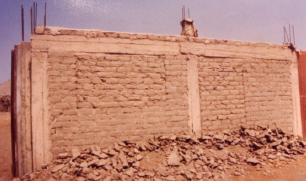1 Professor, Department of Engineering, Catholic University of Peru, Av Universitaria 1801, Lima 32, Peru, asanbar@pucp.edu.pe
2 Professor, Department of Engineering, Catholic University of Peru, Av Universitaria 1801, Lima 32, Peru,dquiun@pucp.edu.pe
ABSTRACT
The traditional constructions of unreinforced adobe are highly vulnerable to earthquakes, mostly affecting people of low income. The experimental research done in order to mitigate this problem has tried to reinforce adobe constructions with internal cane meshes, external welded-wire meshes or similar. In recent years, laboratory tests have been developed to study adobe confined with reinforced concrete elements under seismic loads, with good results. The tests include cyclic lateral loads on full scale walls and shaking table tests on one and two-story models.
Based on the results of these experiments, a seismic design proposal for confined adobe houses up to two stories was developed. The theory of the proposal uses the criteria of ultimate strength and performance-based design used in confined masonry of fired clay bricks, acknowledging the poor quality and low resistance of the traditional adobe masonry. The application of this theory leads to low-strength concrete columns and beams and minimum reinforcement. In this way, the design proposal can be useful for people of low income.
KEYWORDS: codes, adobe, confined adobe, seismic design, experimental tests
145.pdf



